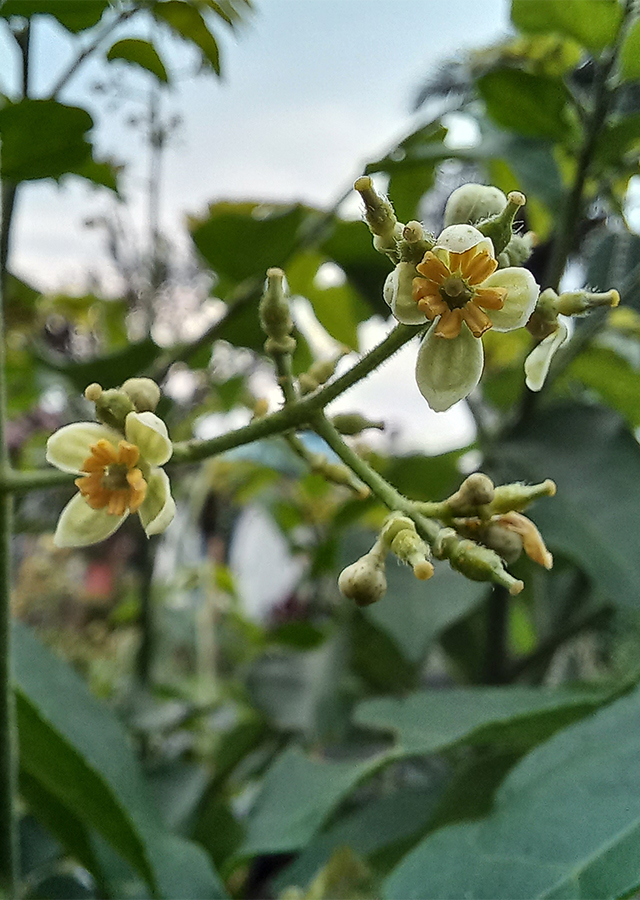Pink Lime Berry
Clausena excavata Burm.f.
Rutaceae
Location in our garden
Beneficial Weed



Synonym
Lawsonia falcata Lour.
Amyris punctata Roxb. ex Colebr.
Murraya burmanni Spreng.
Habitus
Trees. A shrub or small tree, up to 15 m in height, and covered with soft hairs all over.
Part Used
Leaves
Bark
Flowers
Roots
Stem
Growing Requirements
Full Sunshine
Need Shade
Habitat
Forest
Terrestrial
Overview
Pink lime berry is native from the Himalayas to southern China, southern Taiwan, throughout Indo-China, Thailand, Malaysia, Indonesia and the Philippines to New Guinea. Currently cultivated pan-tropical as an ornamental. The plant is harvested from the wild for local use as a food and medicine. The plants has edible fruits and edible leaves. Usually, Tamils are cook and eaten the leaves as a potherb. Pink lime berry is also used in the folk medicine. It is considered to be astringent, bitter, emmenagogue and tonic. It is used in many parts of its range, especially in the treatment of digestive complaints. In addition to being used as food and medicine, the plants has leaves and bark that contain essential oils that are used in the perfume industry.
Vernacular Names
Seitnan (Burmese), Santhrok damney (Cambodian), Jia huang pi, Ye huang pi, Jia juang pi (Chinese), Kurausena ekisukyabata, Kurausena ekisukavata (Japanese), Chamat, Hatsa khun (Thai), Daun sicerek, Cherek hitam, Kemantu hitam, Semeru, Seserek (Malay).
Agroecology
Pink lime berry establishes dense stands along the sides of roads and in disturbed areas. Evergreen and deciduous forests in Laos. Secondary forest, brushwood and disturbed areas around villages, at elevations from sea-level to 1,500 metres. The plants is grow in full sun for best results, but also can tolerate in light shade.
Morphology
- Root - taproot.
- Stems - straight bole, which sometimes branches from the base, covered with soft hairs, cylindrical, brown.
- Leaves - hanging freely at the end of the branches, pinnate, with 7–20 pairs of leaflets and dark green in colour. Its alternate, short-stalked leaves have thinly leathery leaf blades that are oblong-egg-shaped to lance-shaped or slightly crescent-shaped, apex tapered or acuminate, asymmetrical bases, glabrous above, sparsely hairy below, full of translucent dots when hold against the light. They also have slightly wavy or faintly notched margins. The leaflets have a characteristic curry-like smell when crushed. Transluscent oil glands numerous, conspicuous.
- Flowers - small, green flowering shoots are 10–45 cm long, and found from the end of leafy twigs, or at the leaf axils, pubescent, shortly pedicel. Calyx usually 4-lobed. Petals white or pale yellowish white, usually 4, ovate to obovate to oblong. Stamens usually 8. Ovary entire, glandular and hairy.
- Fruits - broadly ellipsoid, 0.8–2 cm long, smooth, glabrous, ripen green then white or pinkish, translucent, and found in hanging shoots. They emit a smell of sour, resinous oranges when crushed.
- Seed - 1-2 per fruit, oblong.
Cultivation
- Propagated by seed.
- Seeds dispersed by birds.
Chemical Constituents
Phenolics, quercetin, myricetin, kaempferol, carbazole alkaloids (clausine-B, -H, -M, -N, -O, -P, -Q, -R, -S, -U, -V, -Z, clausenatine- A, clausenamine D, E, F, G, clauszoline-A, -B, -C, -D, -E, -F, -G, -H, -I, -J, -K, -L, -M , 3-carbomethoxy-2-hydroxy-7-methoxycarbazole, clausenol, clausenine), biscarbazole alkaloids (clausemine-A), carbazole derivatives (3-formylcarbazole, mukonal, 3-methoxycarbonylcarbazole, murrayanin, 2-hydroxy-3-formyl-7 -methoxycarbazole), coumarins (excavacoumarin A,B, C, D, E, F, and G, clausenaexcavin, clauslactones A, B, C, D, E, F, G, H, I, and J), limonoids (clausenolide -1-ethylether, clausenarin, clausenolide-1-methylether), essential oils (beta-caryophyllene, germacrene B, and beta-phellandrene).
Traditional Medicinal Uses
- Studies have shown immunomodulatory, anti-cancer, anti-viral, antinociceptive, astringent, mosquitocidal, fungicidal properties.
- Pounded root used as poultice for sores, including ulcerations of the nose, or sometimes for yaws and a decoction of roots used for fevers and headaches.
- In Orissa, India, paste of roots used for body pain.
- A decoction of the roots, flowers or leaves is taken for treating bowel complaints, such as colic, dyspepsia and stomach-ache.
- Ulcerations of the nose treated by fumigation from burning leaves and bark.
- A decoction of the leaves is taken after childbirth and also to treat stomach troubles, and the poultice of pounded leaves applied to the head for headaches. The juice from the leaves is taken as a treatment for intestinal worms or cough.
- In China and Malays, it used for treatment of snakebites.
- In Vietnam, used to promote menstruation.
- Decayed teeth can be treated using the drayed and powdered rootstock.
Part Used
Reference Sources
- Flora Fauna Web. 2019. Clausena excavata Burm.f. https://www.nparks.gov.sg/florafaunaweb/flora/3/6/3675. 3-11-2021.
- CSIRO. 2020. Australian Tropical Rainforest Plants: Clausena excavata Burm.f. https://apps.lucidcentral.org/rainforest/text/entities/clausena_excavata.htm. 3-11-2021.
- Arbab IA et al. 2011. Review: Clausena excavata Burm. f. (Rutaceae): A review of its traditional uses, pharmacological and phytochemical properties. Journal of Medicinal Plants Research Vol. 5(33). DOI: 10.5897/JMPR11.013.
- Stuartxchange. 2020. Philippine Medicinal Plants: Buriñgit. http://www.stuartxchange.org/Buringit.html. 3-11-2021.
- Asian Plant. Clausena excavata Burm., Fl. Ind. (N.L.Burman) 89 t.29 (1768). https://asianplant.net/Rutaceae/Clausena_excavata.htm. 3-11-2021.
- Useful Tropical Plants Database. 2021. Clausena excavata. http://tropical.theferns.info/viewtropical.php?id=Clausena+excavata. 3-11-2021.



